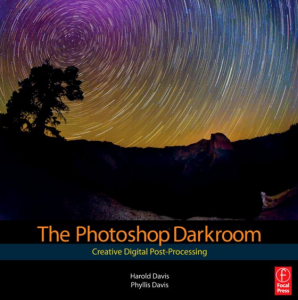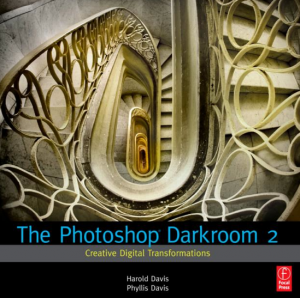Â
The Photoshop Darkroom, Creative Digital Post-Processing
by Harold and Phyllis Davis
Focal Press
Price: $39.95
The Photoshop Darkroom 2, Creative Digital Transformations
by Harold and Phyllis Davis
Focal Press
Price: $39.95
Published roughly two years apart, these companion books are the equivalent of a one semester crash course in Photoshop. Both books are lavishly illustrated on quality stock. Both provide step-by-step instructions for achieving a wide range of effects in Photoshop. The tutorials do not cover everything there is to know in Photoshop. The focus appears to be a mix of simple tasks, like moving images from the camera to the computer, to the more complex, such as using LAB channel adjustments to change colors.
Photoshop is a difficult application that is an essential tool for the professional photographer or photo editor. If the Davises’ books make anything clear, it is that the average hobbyist faces a steep and largely unnecessary learning curve if he or she decides to tackle Photoshop. For art directors and other graphics professionals, knowledge of Photoshop is a necessity; for everyone else, it’s overkill. The depth of knowledge displayed by the Davises illustrates this beyond a doubt.
If you want to learn Photoshop, you must first learn Photoshop’s language — what are curves, layers, or LAB channels, for example? If you think the answers are simple, consider that both books contain a glossary, yet even the glossaries stutter when trying to explain a term. For example, if you look up Layer (as opposed to Adjustment Layer), you’ll find this: “Photoshop documents are comprised of layers stacked on top of each other.” That sentence does not tell us what a layer is.
All of which is to say that the Davises had their work cut out for them when they embarked on this ambitious project. It is difficult if not impossible to make a book that may be useful to students who come to the classroom with little or no preparation as well as to those students who have at least a passing familiarity with the application and its terminology. The former requires a clear teacher to elaborate on the lessons presented in the books.
The Davises try to get around this dilemma, with varying success, by including an unusual design feature: numbered notes in hand-printed text appear as pull quotes on nearly every page to walk you through several tasks. But at times you’ll encounter problems even with these profuse notes, especially if you’re a Mac user and you’re instructed to “hold down the Alt key.” The Alt key on a Mac keyboard is the Option key and these authors should have noted as much. In some places it actually does say Alt/Option, but that’s not consistent throughout the books.
An argument can be made that the second book in this set, dealing with “Creative Digital Transformations,” contains many elements that should have been in the first book. In the digital transformations title the authors discuss methods of composing photos depending on what type of post-processing you plan to apply to the image before you even press the shutter. For example, if you’re planning on applying High Dynamic Range (HDR) toning, that will make your photo look more like oil or watercolor paintings, you may set up the shots with less or more contrast than you might a scene you plan to convert to black and white or sepia. There’s a brief discussion of this topic in the first book, as is the case with some other repeated topics, but in expanded form in the second one
Both books come with extensive Table of Contents backed up by useful Index.
The Photoshop Darkroom, Creative Digital Post-Processing and The Photoshop Darkroom 2, Creative Digital Transformations are designed so that you can dip in at any point and learn a particular task, which is to say that one chapter does not build on the previous one. For some readers, this will be a relief, but I found it distracting because, once again, it requires foreknowledge of many of Photoshop’s most important characteristics and its specialized vocabulary.
Both books will prove useful to someone with a basic knowledge of Photoshop. They are considerably less useful to beginners, who should definitely look elsewhere for Photoshop fundamentals.
MyMac review rating for both books is 7 out of 10



Leave a Reply
You must be logged in to post a comment.